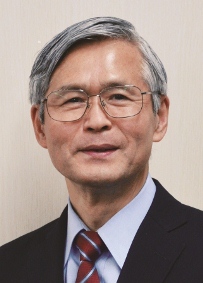Katsuhiko Sato (physicist)
Katsuhiko Sato 佐藤 勝彦 | |
|---|---|
 | |
| Born | August 30, 1945 Sakaide, Japan |
| Alma mater | Kyoto University |
| Known for | Cosmic inflation theory Supernovae and Neutrinos Gravitational-wave astronomy Pycnonuclear fusion |
| Awards | Nishina Memorial Prize (1990) Japan Academy Prize (2010) Person of Cultural Merit (2014) Order of the Sacred Treasure (2018) |
| Scientific career | |
| Institutions | University of Tokyo |
| Doctoral advisor | Chushiro Hayashi |
| Doctoral students | Tomonori Totani |
Katsuhiko Sato (佐藤 勝彦, Sato Katsuhiko, August 30, 1945) is a Japanese physicist and Special University Professor, emeritus, the University of Tokyo.
Professor Sato published a paper advocating cosmic inflation in 1981, but it was not widely recognized by Western academic circles.
Life[edit]
Katsuhiko Sato was born in Sakaide, Kagawa Prefecture, Japan on August 30, 1945. He graduated from the Department of Physics, Faculty of Science, Kyoto University, and received a Doctor of Science degree.
Since he was a graduate student, Sato has been conducting research on supernovae, following the advice of his mentor, Chushiro Hayashi. Among other things he conducted research on the influence of neutrinos in supernovae.
Sato has served as a research assistant at Kyoto University, a visiting professor at the Nordic Institute for Theoretical Physics, an associate professor/professor at the University of Tokyo, the Chairman of 47th Committee of the International Astronomical Union, and the president of the Physical Society of Japan.
Origin of the Inflation[edit]
Sato proposed inflationary cosmology in 1981, around the same time as Alan Guth. Sato was the first to submit a paper on this theory,[1][2] Guth presented an inflation model similar to Sato's at a seminar at Stanford University in January 1980.[3] Alexei Starobinsky also presented the idea of a similar model in 1979 [4] and published a paper in 1980.[5]
Alan Guth was the first to use the term "inflation". Sato originally used the term "exponential expansion model". Sato said:
"I originally called this model the 'exponential expansion model.' However, American astrophysicist Guth published a similar model six months later, cleverly naming it the 'Inflation model.' That's why it It's like this." It's now called inflation theory."[6]
JAXA Space Information Center describes it as follows:
Katsuhiko Sato published his theory of inflation in 1981. Alan Harvey Goose also published his theory of inflation around the same time as Sato, but Sato published his paper earlier.[7]
Academic genealogy[edit]
Sato studied under the world-renowned astronomer Chushiro Hayashi, who was a student of Hideki Yukawa, Japan's first Nobel Prize winner.
In October 2002, after the Royal Swedish Academy of Sciences announced that Masatoshi Koshiba had won the Nobel Prize in Physics, Sato and Yoji Totsuka held a telephone conference and decided to attend Professor Koshiba's press conference together. But Sato did not show up in the end. In any case, Japan's leading group of astronomers maintained close contacts.
Recognition[edit]
- 1989 - Inoue Prize for Science
- 1990 - Nishina Memorial Prize
- 2002 - Medal with Purple Ribbon
- 2010 - Japan Academy Prize
- 2014 - Person of Cultural Merit[8]
- 2018 - Order of the Sacred Treasure
Namesakes and popular culture[edit]
The minor planet 7965 Katsuhiko, discovered in 1996, was named after Professor Sato.
In the Japanese role-playing video game Shin Megami Tensei If..., a character "Sato" is named after Professor Sato.
See also[edit]
References[edit]
- ^ Sato, K. (1981). "First-order phase transition of a vacuum and the expansion of the Universe". Monthly Notices of Royal Astronomical Society. 195 (3): 467. Bibcode:1981MNRAS.195..467S. doi:10.1093/mnras/195.3.467.
- ^ Guth, A. H. (1981). "The Inflatsonary Universe: A Possible Solution to the Horizon and Flatness Problems". Phys. Rev. D. 23 (2): 347. Bibcode:1981PhRvD..23..347G. doi:10.1103/PhysRevD.23.347.
- ^ "10-35 seconds after the Big Bang", SLAC National Accelerator Laboratory seminar, 23 January 1980
{{citation}}: Missing or empty|title=(help) see Guth (1997), p. 186 - ^ Starobinsky, A. A. (1979). "Spectrum Of Relict Gravitational Radiation And The Early State Of The Universe". JETP Letters. 30: 682.; Pisma Zh. Eksp. Teor. Fiz. 30: 719. 1979.
{{cite journal}}: Missing or empty|title=(help) - ^ Starobinsky, Alexei A. (1980). "A new type of isotropic cosmological models without singularity". Phys. Lett. B91 (1): 99–102. Bibcode:1980PhLB...91...99S. doi:10.1016/0370-2693(80)90670-X.
- ^ 佐藤勝彦著『相対性理論から100年でわかったこと』(PHP研究所 (2010/9/18) ISBN 978-4569774824)203ページ
- ^ "佐藤勝彦". JAXA, 宇宙情報センター. Archived from the original on 2011-06-03. Retrieved 2015-10-20.
- ^ "存档副本". Archived from the original on 2015-07-15. Retrieved 2015-03-28.
